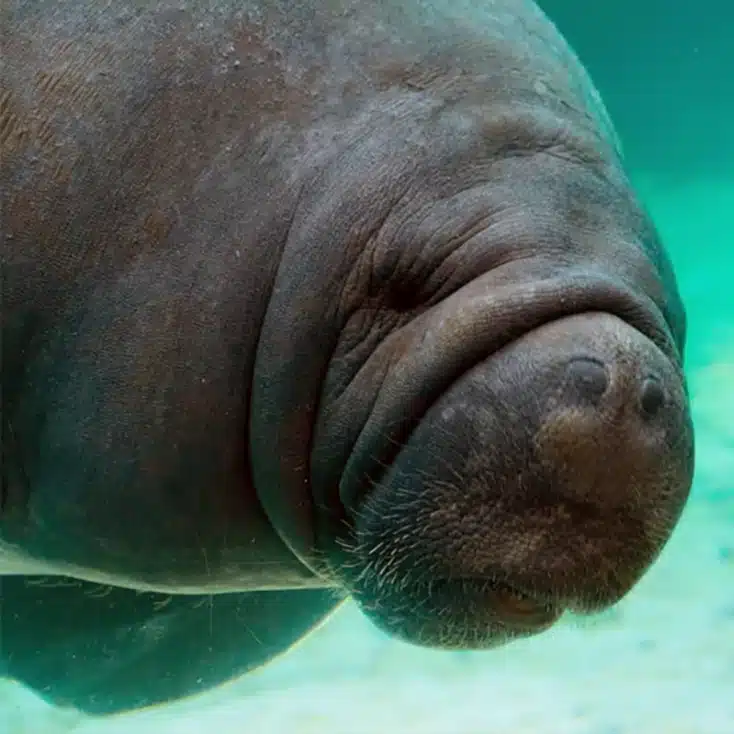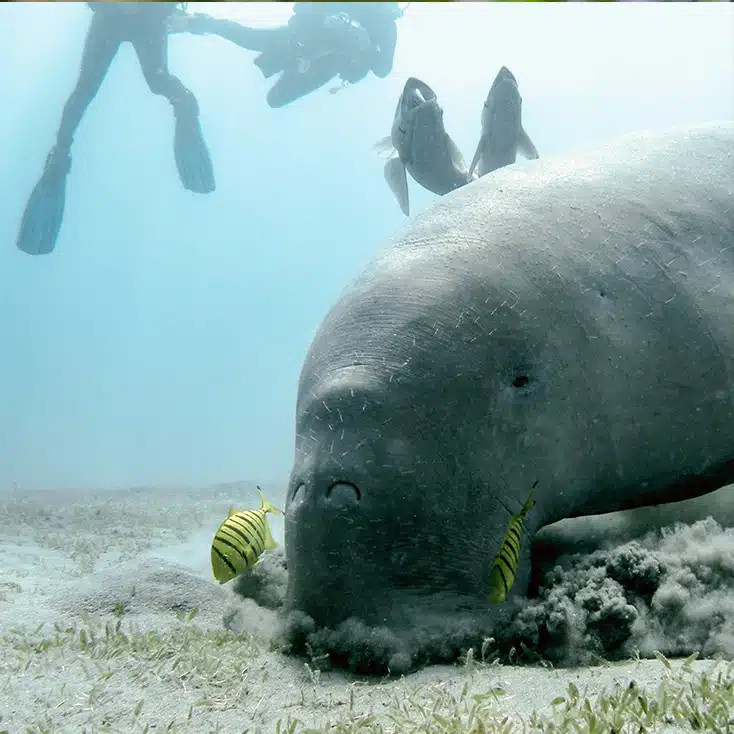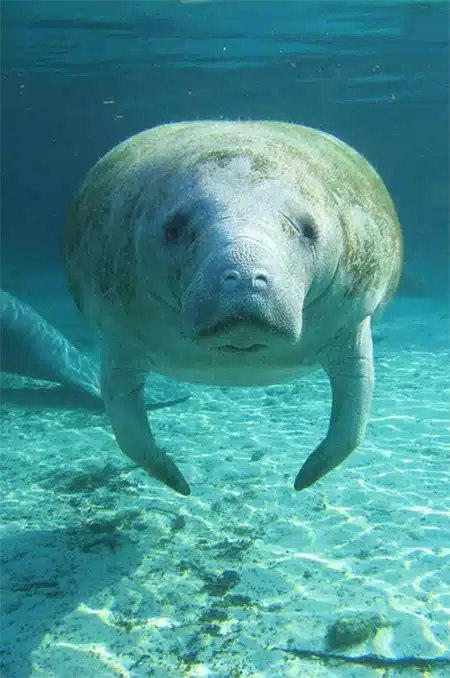There are only three living species of manatees and one of dugong being the only four species of the order Sirenia.
Habitat, feeding, reproduction, social structure, anatomy and all the information about manatees.
The pacific nature and the careless behavior of manatees, made them victims of many dangers.
Introduction to Manatees
One of the most unusual of all the aquatic life out there is the manatee. You may also hear them called by the name of sea cows due to the resemblance they have to such land animals. They lead a very solitary life in the water unless they are mating or they are female with young to care for. They are plant eaters so they really don’t bother any other creatures in the water.
The manatee does have some natural enemies though to worry about when they are in the water. Most of the time it is the young and the weak that are the most vulnerable to such predators though. They include crocodiles, alligators and sharks. What predators they have to worry about depends on the location where they live.
Of course their biggest threat comes from humans. They continue to destroy the natural environment. They also pollute the waters and this has lead to a significant number of them being killed in the past couple of decades.
You will only find manatee’s where they water is at least 60 degrees Fahrenheit. They tend to like it much warmer than that. This is why so many of them migrate towards Florida in the winter time. They do communicate among each other at this time as well as time part in the mating rituals. Many tourists from around the world head to Florida during this time of year to observe the manatee’s as they migrate. In fact, there are some areas that allow the humans to swim with them.
The manatee spends most of its time either eating or sleeping. They spend their entire lives in the water. They are herbivores and enjoy a variety of many different plants that are found towards the bottom of the body of water they happen to be in. They tend to stay close to the coastal areas that are shallow to search for food unless it is scarce. Then they will move to deeper waters.

A great deal of what we know about the manatee comes from satellite tracking devices. They are in place by many different agencies including the U.S. Fish and Wildlife Service, the U.S. Geological Survey, and the Manatee Rehabilitation Partnership. Due to their dedication we are able to see patterns of migration and other behaviors of this mystifying animal.
In the wild, a manatee can live up to 60 years of age with the right condition. They do seem to do quite well in captivity. However, the females can show signs of stress by not mating for several years after they are placed in captivity. Right now the oldest living manatee in captivity is 51 years of age. His name is Snooty and he was born in captivity in 1948.
While there is evidence that the manatee evolved more than 60 million years ago to survive in water, their time may be running out. They are considered to be vulnerable for extinction at this time. This is due to a combination of things including humans in the water, swallowing fishing line, natural predators, and even global warming. There are many conservation efforts in place though so hopefully these amazing mammals will be able to continue being a part of the Earth for millions more years.
Interesting Manatee Facts
- Manatees are herbivores, which means that they only consume plants.
- A manatee can live to be up to 60 years of age in the wild.
- See more facts…
Manatee Species List
Discover More
Frequently Asked Questions (FAQ) about Manatees
What is a manatee?
A manatee is a living being that belongs to the kingdom Animalia, the class Mammalia, the order Sirenia and the family Trichechidae, also known as “Sea Cow.” It is classified as a herbivorous animal, although some observations have revealed a minimal percentage of meat in its diet. Manatees have a long, robust and rounded body that is fully adapted to live in the aquatic environment.
Officially three species and two subspecies are recognized, which survive exclusively in tropical waters that are mostly freshwater, but two of them inhabit in salty waters too.
What animals are related to manatees?
According to DNA analyzes, manatees are relatives to elephants, hyraxes, and anteaters. Based on research, scientists think that the ancestors of modern manatees lived during the Miocene, between 23.03 and 5.55 million years ago.
What is a group of manatees called?
Manatees are mammals that do not form groups, do not have evident leaders or hierarchical structures. They are semi-social animals that can live peacefully with other partners without relying on them for protection or cooperation in any situation. However, manatees sometimes form groups or aggregations which are called herds. Baby Animals names and groups.
These groups are referred as aggregations because manatees can gather at some place to meet their individual needs, not to get something from the group. For example, they rest in some communal areas or look for food in the same location than others, but they do not cooperate to perform any of these activities like a group.
On the other hand, the “mating herds” are the groups of several males in search of receptive females during the breeding seasons. These groups follow females in heat for a few days or weeks until some of the group succeed in copulating.
What is a sea cow?
Sea cow is the colloquial name given to manatees, marine mammals of the Trichechidae family. This name probably came from their body shape and peaceful behavior that both animals have in common. However, some think that it is because manatees are herbivores just like cows.
What color are manatees?
Manatees are gray, but this color can vary from light to dark. Some may look rosaceous in some areas or greenish because of the algae developed on their skin.
Do manatees make sounds?
Although it may not seem so, manatees can make different sounds according to the situation. Among them are the squeaks, grunts, and squeaks.
There are typical sounds of social interaction, annoyance, fear, protection of their offspring or the announcement of the presence of a predator.
What is a baby manatee called?
Manatee young are called calves.
What do Sea Cows eat?
Sea cows, or more commonly known manatees, feed on more than 60 types of plants and sometimes only in a few proportions, their diet includes fish and clams.
What do Manatees eat?
Manatees have an herbivorous diet that includes seagrasses and more than sixty types of plants, among which are the algae, water hyacinth, plants of the genus Hydrilla and mangrove leaves to mention some examples.
The African manatees that surround Sierra Leone enter the rice fields to get the grain and others fed on acorns. However, meat can form a small part of the diet of some populations. Fish and clams are part of the food of the Antilles and African manatees, something that questions the belief that these mammals are fully herbivores.
How do manatees mate?
Manatees reproduce sexually. After they reach sexual maturity, that in females occurs at the age of three years and in males until the age of nine or ten, the latter begins the process by looking for receptive females. It is not a single individual, but several bulls form a “mating herd” to search for cows in heat which they will follow for days or weeks until mating.
Several males may mate with a single sexual partner, but none form a permanent bond beyond copulation.
The position of a male and a female during mating is somewhat strange since the sexual organs of the female are located by the anus, while for bulls they are found at the level of the navel. Once they copulate, each one goes on his way.
How do manatees sleep?
Manatees can rest during the day and night for short periods. Some rest just below the surface of the water, but they usually stay at the bottom and reach the surface to breathe every three to five minutes. The time depends on their level of activity or their energy depletion, as there are individuals who have to breathe every 30 seconds while others who can do it every 20 minutes.
A fascinating fact is that this action of reaching the surface to breathe and going back to the bottom to rest again is done involuntarily as part of their instinct. Some scientists even believe that the manatees resting on the bottom go to the surface without being fully awake.
Are manatees endangered?
There are three species of manatees: the Amazonian manatee, the African manatee, and the West Indian manatee, and all three have a conservation status as “Vulnerable” on the IUCN Red List of Threatened Species (The International Union for the Conservation of Nature). Being “Vulnerable” means that an animal faces a high risk of extinction in the wild.
The problem does not end here. The only two subspecies of the West Indian manatee, which are the Caribbean manatee and the Florida manatee, both are “Endangered.” This status means that they face a very high risk of disappearing in the wild.
Among the causes of the decline of manatees, we can mention commercial catch for meat consumption, collisions with boats, human settlements in coastal areas leading to pollution and loss of warm water habitats.
How do manatees defend themselves?
Manatees are slow-moving animals and do not have convincing defense characteristics like sharp fangs or claws to deter their strongest and most aggressive opponents such as sharks, alligators or very rarely jaguars. However, they have other peculiarities that do not make them easy prey.
First, manatees stay most of the time in shallow waters; also, some of the bodies of water they inhabit have crystalline waters where they can see the bottom, something that does not help crocodiles or alligators. Second, its size and body thickness is not something that facilitates its capture.
Finally, while they usually make slow movements, few know an essential tool for survival: Fleeing. Some manatees flee from the danger at more than 30 kilometers per hour, while most of their lives they move at no more than 10 kilometers per hour.
What do manatees look like?
Manatees are robust, elongated and rounded mammals very similar to the shape of a barrel. Their coloration is gray with different tonalities of such color from light to dark, and the texture of their skin is rough with a cover of few thin hairs.
They have two long pectoral fins and a large, flat tail shaped like a palette. Their face has a short, thick snout with a prehensile upper lip, plus nostrils positioned above for easy breathing when reaching the surface.
On average, adult manatees measure from 9 to 13 feet in length and a weight between 900 and 1200 pounds, which make them a large animal.
What are manatees' predators
Manatees have very few predators that attack them, so they do not have to worry about fleeing from big carnivores all the time. However, they know that in the presence of certain creatures it is better to take precautions and stay alert.
Crocodiles, alligators, caimans, jaguars and some types of sharks, can give them problems, although they do not always catch their victims because of several factors that give manatees an advantage.
What did manatees evolve from?
Scientific research has returned compelling data about the evolution of manatees and their ancestors, although not all reach the same conclusions. Some believe that both manatees and dugongs evolved from terrestrial mammals more than 60 million years ago, but others suggest that they did so from herbivores very similar to pigs that were closely related to water and which gradually adapted to live in an aquatic environment.
DNA tests revealed that their closest modern relatives are the elephants, followed by the hyraxes and anteaters. While they may not physically resemble each other, the biochemical analyzes found a relationship between the four animals, probably because they had a common ancestor from which all split and developed based on their geographic location, food, climate, etc.
What is the difference between a dugong and a manatee?
Maybe if you look at a dugong and a manatee for a couple of seconds, you will not notice any physical differences, but a closer look will show the specific characteristics of each one.
The first feature to consider is that manatees are larger than dugongs since the latter rarely exceed three meters in length, while “sea cows” can reach up to four meters, although this is not enough to identify both species.
Manatees live in West Africa, the Caribbean, and parts of Central and South America, while dugongs are distributed mainly through East Africa, Southern Asia, and Northern Australia.
Dugongs lack nails on their fins while the manatees not except the Amazonian manatees which differentiate from them because of all other features.
The tail is perhaps the easiest visual element to identify them. The Trichechus have a very flat palette-like tail while the Dugongidae family has a tail similar to that of dolphins with separated lobes.
The mouth is also a distinctive sign as well. Manatees have short snouts with a split and a prehensile upper lip. Dugongs, on the contrary, have wide snouts directed downward with an entire upper lip. Also, dugongs have a pair of incisors similar to fangs that develop in youth while manatees lack them.




